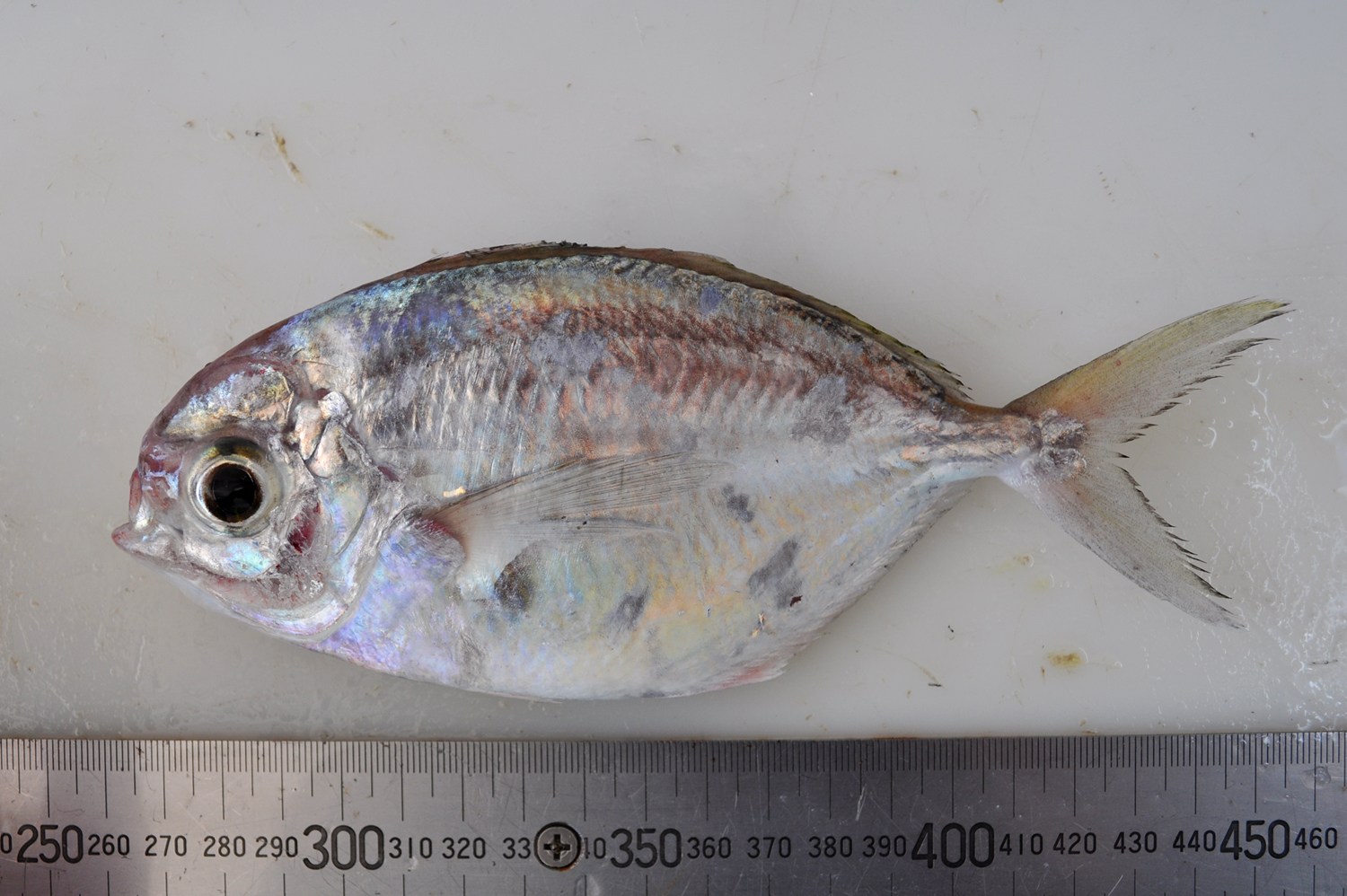Indian Driftfish, Ariomma indicum (Day 1870)
Other Names: Indian Ariomma, Indian Eyebrow-fish

An Indian Driftfish, Ariomma indicum, from . Source: . License:
Summary:
A silvery driftfish with a bluish tinge on the back, greyish fins, black inside the gill cover, and the iris with two golden crescents separated by a vertical dark region. Large individuals may be uniformly blackish.
Cite this page as:
Bray, D.J. 2023, Ariomma indicum in Fishes of Australia, accessed 27 Jun 2025, https://fishesofaustralia.net.au/Home/species/741
Indian Driftfish, Ariomma indicum (Day 1870)
More Info
|
Distribution |
Montebello Island, Western Australia, east of Dunk Island, Queensland. Elsewhere the species occurs in the tropical, Indo-west Pacific.Small schools inhabit muddy areas on the continental shelf and upper slope, and may be pelagic at night and demersal by day. |
|
Features |
Dorsal fin X-XI + I,13-16; Anal fin III, 14-15. Body depth usually 2.0–2.4 in SL; teeth absent from roof of mouth; eyes large, surrounded by thick adipose tissue; caudal peduncle short, almost square in cross-section with two fleshy keels at base of caudal fin. Dorsal-fin spines slender, soft dorsal and anal rays short; pelvic fins short, not reaching anus; caudal fin lobes not capable of folding into a single lobe. |
|
Feeding |
Feeds mainly on zooplankton. |
|
Etymology |
The species is named indica in reference to the type locality, Madras, India. |
|
Species Citation |
Cubiceps indicus Day 1870, Proceedings of the Zoological Society of London 1870: 690. Type locality: Madras, India. |
|
Author |
Bray, D.J. 2023 |
|
Resources |
Indian Driftfish, Ariomma indicum (Day 1870)
References
Allen, G.R. 1997. Marine Fishes of Tropical Australia and South-east Asia. Perth : Western Australian Museum 292 pp. 106 pls.
Allen, G.R. & Swainston, R. 1988. The Marine Fishes of North-Western Australia. A field guide for anglers and divers. Perth, WA : Western Australian Museum vi 201 pp., 70 pls.
Day, F. 1870. On the fishes of the Andaman Islands. Proceedings of the Zoological Society of London 1870: 677-705 See ref at BHL
Ferraris, C.J. Jr, McGrouther, M.A. & Parkinson, K.L. 2000. A critical review of the types and putative types of southern Asian marine and freshwater fish species in the Australian Museum named by Francis Day. Records of the Australian Museum 52: 289-306
Gloerfelt-Tarp, T. & Kailola, P.J. 1984. Trawled Fishes of Southern Indonesia and Northwest Australia. Jakarta : Dir. Gen. Fish. (Indonesia), German Tech. Coop., Aust. Dev. Ass. Bur. 406 pp.
Haedrich, R.L. 1967. The stromateoid fishes; systematics and a classification. Bulletin of the Museum of Comparative Zoology, Harvard 135(2): 31-139 figs 1-56
Haedrich, R.L. 1967. The stromateoid fishes: systematics and a classification. Bulletin of the Museum of Comparative Zoology, Harvard 135(5): 31-139
Larson, H.K., Williams, R.S. & Hammer, M.P. 2013. An annotated checklist of the fishes of the Northern Territory, Australia. Zootaxa 3696(1): 1-293.
Last, P.R. 2001. Nomeidae, Ariommatidae, Tetragonuridae. pp. 3771-3785 in Carpenter, K.E. & Niem, T.H. (eds). The Living Marine Resources of the Western Central Pacific. FAO Species Identification Guide for Fisheries Purposes. Rome : FAO Vol. 6 pp. 3381-4218.
Parin, N.V. & Piotrovsky, A.S. 2004. Stromateoid fishes (suborder Stromateoidei) of the Indian Ocean (species composition, distribution, biology, and fisheries). Journal of Ichthyology 44(Suppl. 1): 33-62
Russell, B.C. & Houston, W. 1989. Offshore fishes of the Arafura Sea. The Beagle, Records of the Museums and Art Galleries of the Northern Territory 6(1): 69-84
Sainsbury, K.J., Kailola, P.J. & Leyland, G.G. 1984. Continental Shelf Fishes of Northern and North-Western Australia. Canberra : Fisheries Information Service 375 pp. figs & pls.




